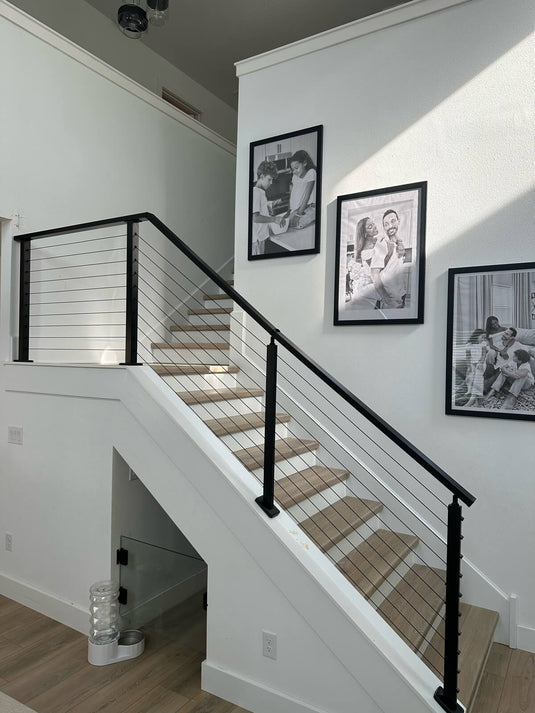TABLE OF CONTENTS
How to Cut Stainless Steel Handrails?
Cutting handrails is a crucial step in the installation of railing systems. Precise cutting of stainless steel cable handrail ends is not only important for enhancing the overall aesthetic but also ensures the stability and safety of the installation. However, cutting handrails requires careful handling, and knowing how to cut handrail ends and the correct angle to cut handrail ends is key to achieving a smooth and precise result.
This article will cover the tools needed for cutting stainless steel cable handrail, proper cutting techniques, and solutions to common damage issues, helping you achieve a flawless handrail cut.

What Tools Are Needed for Cutting Handrails?
Choosing the right tools is key to ensuring success. Different materials for handrails require different cutting tools, and you can purchase tools based on your specific needs.
Cutting Tools
- Cutting Machine
- Resin grinding wheel saw blade/Hard metal wheel saw blade
💡We recommend using the Resin grinding wheel saw blade to cut the stainless steel handrails and using the Hard metal wheel saw blade to cut the aluminum handrails.
Other Tools
- Ruler
- Marker Pen
- File
- Cutting Fluid / Coolant
Protective Equipment
- Safety Goggles
- Protective Gloves
- Dust Mask
- Earplugs
How to Properly Cut Stainless Steel Handrails?
1. Preparation
- Purchase the materials and use a tape measure and marking pen to accurately measure and mark the cutting area.
2. Set Up the Cutting Area
- Secure the handrail to the workbench, ensuring it doesn’t move during the cutting process. Align the cutting tool or operation direction parallel to the marked line on the handrail for precise handrail angle cuts.
- To prevent the paint on the stainless steel handrail from melting during cutting, we recommend applying blue masking tape to the area before using a resin cutting disc.
3. Cutting Process
- During the cutting process, use coolant to maintain the temperature of the tool and handrail, preventing overheating that could cause material distortion or paint melting.
- When starting the cut, maintain a steady speed and avoid cutting too quickly to prevent excessive heat buildup. Cut steadily, ensuring stable contact between the cutting tool and the handrail.
4. Safety Operations
- Ensure you wear safety goggles, protective gloves, a mask, and earplugs to protect yourself from metal debris, dust, and noise.
- Regularly check the condition of the tools to ensure the cutting machine is functioning properly and free from defects. Avoid using damaged or worn-out cutting discs.
5. Post-Cutting Treatment
- After cutting, use a file or polishing tool to remove any burrs from the cut edges to prevent scratches or injuries. Then, use a cleaning cloth to wipe down the handrail surface, removing metal debris and any residue from the cutting process.
Common Problems and Solutions in Cutting Handrails
Question 1: After cutting the handrail, oxidation occurs on the edges, resembling rust or white edges.

-
Solution 1
- First, use sandpaper to manually grind the rusty areas, then spray metal anti-rust oil on the metal surface.
-
Solution 2
- Apply stainless steel pickling paste to the rusty areas, leave it for a few hours, and then wipe it off. (This solution is recommended as it is simpler.)
Question 2: After cutting the handrail, the gap at the junction of the handrail is large, affecting its appearance.
-
Solution 1
-
For brushed stainless steel handrails, apply painter's tape to the edges of the handrail, and use a glass adhesive (e.g., gray) that matches the brushed color to fill the gap.

-
For brushed stainless steel handrails, apply painter's tape to the edges of the handrail, and use a glass adhesive (e.g., gray) that matches the brushed color to fill the gap.
-
Solution 2
- For black stainless steel handrails, gently tap the handrail with a hammer to reduce the gap at the junction, remove debris, then use a file to smooth the surface. Apply painter's tape to the edges of the handrail and spray with black paint. Alternatively, you can use the seam ring which included in the package to cover the part.
-
Solution 3
- Stainless steel cover plates can be used for decorative treatment, but this solution requires custom stainless steel cover plates, which can be costly.

- Stainless steel cover plates can be used for decorative treatment, but this solution requires custom stainless steel cover plates, which can be costly.
Question 3: After cutting the handrail, burrs or sharp edges appear, which could cause cuts.
-
Solution 1
- Use a hand grinder, sandpaper, or file to smooth the edges of the stainless steel, removing the burrs and sharp parts to make them smooth.
Conclusion

Cutting handrails is a common task in installing cable railing systems, and mastering the right techniques can make the process easier and safer. By understanding and following the basic steps, you will be able to complete the cutting of stainless steel cable handrails smoothly and ensure high-quality installation results. If you encounter any issues during the process, feel free to contact the Muzata professional team. You can call 888-680-8850 or email support@muzata.com for assistance, and we will be happy to provide support and answers.
------>>> Muzata Free Design Service




